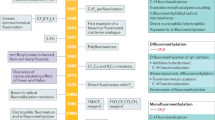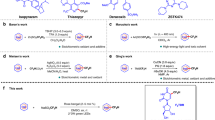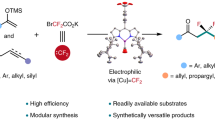Abstract
Recent advances in catalysis have made the incorporation of fluorine into complex organic molecules easier than ever before, but selective, general and practical fluorination reactions remain sought after. Fluorination of molecules often imparts desirable properties, such as metabolic and thermal stability, and fluorinated molecules are therefore frequently used as pharmaceuticals or materials. But the formation of carbon−fluorine bonds in complex molecules is a significant challenge. Here we discuss reactions to make organofluorides that have emerged within the past few years and which exemplify how to overcome some of the intricate challenges associated with fluorination.
This is a preview of subscription content, access via your institution
Access options
Subscribe to this journal
Receive 51 print issues and online access
$199.00 per year
only $3.90 per issue
Buy this article
- Purchase on Springer Link
- Instant access to full article PDF
Prices may be subject to local taxes which are calculated during checkout





Similar content being viewed by others
References
Müller, K., Faeh, C. & Diederich, F. Fluorine in pharmaceuticals: looking beyond intuition. Science 317, 1881–1886 (2007)
Purser, S., Moore, P. R., Swallow, S. & Gouverneur, V. Fluorine in medicinal chemistry. Chem. Soc. Rev. 37, 320–330 (2008)
Jeschke, P. The unique role of fluorine in the design of active ingredients for modern crop production. ChemBioChem 5, 570–589 (2004)
Hung, M. H., Farnham, W. B., Feiring, A. E. & Rozen, S. in Fluoropolymers: Synthesis Vol. 1 (eds Hougham, G., Cassidy, P. E., Johns, K. & Davidson, T. ) 51–66 (Plenum, 1999)
Ametamey, S. M., Honer, M. & Schubiger, P. A. Molecular imaging with PET. Chem. Rev. 108, 1501–1516 (2008)
O’Hagan, D. Understanding organofluorine chemistry. An introduction to the C−F bond. Chem. Soc. Rev. 37, 308–319 (2008)
Curran, D. P. Strategy-level separations in organic synthesis: from planning to practice. Angew. Chem. Int. Edn 37, 1174–1196 (1998)
Patterson, J. C., II & Mosley, M. L. How available is positron emission tomography in the United States? Mol. Imaging Biol. 7, 197–200 (2005)
Kirk, K. L. Fluorination in medicinal chemistry: methods, strategies, and recent developments. Org. Process Res. Dev. 12, 305–321 (2008)
Furuya, T., Kuttruff, C. A. & Ritter, T. Carbon–fluorine bond formation. Curr. Opin. Drug Discov. Dev. 11, 803–819 (2008)
Grushin, V. V. The organometallic fluorine chemistry of palladium and rhodium: studies toward aromatic fluorination. Acc. Chem. Res. 43, 160–171 (2010)
Furuya, T., Klein, J. E. M. N. & Ritter, T. C–F bond formation for the synthesis of aryl fluorides. Synthesis 1804–1821 (2010)
Kirsch, P. Modern Fluoroorganic Chemistry: Synthesis, Reactivity, Applications (Wiley, 2004)
Gribble, G. W. in Progress in the Chemistry of Organic Natural Products Vol. 68 (eds Herz, W., Kirby, G. W., Moore, R. E., Steglich, W. & Tamm, C. ) 1–498 (Springer, 1996)
Gribble, G. W. in Progress in the Chemistry of Organic Natural Products Vol. 91 (eds Kinghord, A. D., Falk, H. & Kobayashi, J. ) 1–613 (Springer, 2009)
O’Hagan, D., Schaffrath, C., Cobb, S. L., Hamilton, J. T. G. & Murphy, C. D. Biochemistry: Biosynthesis of an organofluorine molecule. Nature 416, 279 (2002)
Dong, C. et al. Crystal structure and mechanism of a bacterial fluorinating enzyme. Nature 427, 561–565 (2004)
Shannon, R. D. Revised effective ionic radii and systematic studies of interatomic distances in halides and chalcogenides. Acta Crystallogr. A 32, 751–767 (1976)
Emsley, J. Very strong hydrogen bonds. Chem. Soc. Rev. 9, 91–124 (1980)
Adams, D. J. & Clark, J. H. Nucleophilic routes to selectively fluorinated aromatics. Chem. Soc. Rev. 28, 225–231 (1999)
Luo, Y.-R. Handbook of Bond Dissociation Energies in Organic Compounds (CRC Press, 2002)
Subramanian, M. A. & Manzer, L. E. A “greener” synthetic route for fluoroaromatics via copper(II) fluoride. Science 297, 1665 (2002)
Cope, A. C. & Siekman, R. W. Formation of covalent bonds from platinum or palladium to carbon by direct substitution. J. Am. Chem. Soc. 87, 3272–3273 (1965)
Hull, K. L., Anani, W. Q. & Sanford, M. S. Palladium-catalyzed fluorination of carbon–hydrogen bonds. J. Am. Chem. Soc. 128, 7134–7135 (2006)Describes the first Pd-catalysed C−F bond formation.
Wang, X., Mei, T.-S. & Yu, J.-Q. Versatile Pd(OTf)2·2H2O-catalyzed ortho-fluorination using NMP as a promoter. J. Am. Chem. Soc. 131, 7520–7521 (2009)
Yamada, S., Gavryushin, A. & Knochel, P. Convenient electrophilic fluorination of functionalized aryl and heteroaryl magnesium reagents. Angew. Chem. Int. Edn 49, 2215–2218 (2010)
Anbarasan, P., Neumann, H. & Beller, M. Efficient synthesis of aryl fluorides. Angew. Chem. Int. Edn 49, 2219–2222 (2010)
Powers, D. C. & Ritter, T. Bimetallic Pd(III) complexes in palladium-catalysed carbon−heteroatom bond formation. Nature Chem. 1, 302–309 (2009)
Kaspi, A. W., Yahav-Levi, A., Goldberg, I. & Vigalok, A. Xenon difluoride induced aryl iodide reductive elimination: a simple access to difluoropalladium(II) complexes. Inorg. Chem. 47, 5–7 (2008)
Ball, N. D. & Sanford, M. S. Synthesis and reactivity of a mono-σ-aryl palladium(IV) fluoride complex. J. Am. Chem. Soc. 131, 3796–3797 (2009)
Furuya, T. & Ritter, T. Carbon−fluorine reductive elimination from a high-valent palladium fluoride. J. Am. Chem. Soc. 130, 10060–10061 (2008)Describes the first confirmed Ar−F reductive elimination from a transition metal complex.
Furuya, T. et al. Mechanism of C−F reductive elimination from palladium(IV) fluorides. J. Am. Chem. Soc. 132, 3793–3807 (2010)
Fraser, S. L., Antipin Yu, M., Khroustalyov, V. N. & Grushin, V. V. Molecular fluoro palladium complexes. J. Am. Chem. Soc. 119, 4769–4770 (1997)
Pilon, M. C. & Grushin, V. V. Synthesis and characterization of organopalladium complexes containing a fluoro ligand. Organometallics 17, 1774–1781 (1998)
Grushin, V. V. Palladium fluoride complexes: one more step toward metal-mediated C−F bond formation. Chem. Eur. J. 8, 1006–1014 (2002)
Yandulov, D. V. & Tran, N. T. Aryl–fluoride reductive elimination from Pd(II): feasibility assessment from theory and experiment. J. Am. Chem. Soc. 129, 1342–1358 (2007)
Grushin, V. V. & Marshall, W. J. Ar–F reductive elimination from palladium(II) revisited. Organometallics 26, 4997–5002 (2007)
Watson, D. A. et al. Formation of ArF from LPdAr(F): catalytic conversion of aryl triflates to aryl fluorides. Science 325, 1661–1664 (2009)Reports the first functional-group-tolerant Pd-catalysed Ar−F bond formation using aryl triflates and fluoride.
Fors, B. P., Watson, D. A., Biscoe, M. R. & Buchwald, S. L. A highly active catalyst for Pd-catalyzed amination reactions: cross-coupling reactions using aryl mesylates and the highly selective monoarylation of primary amines using aryl chlorides. J. Am. Chem. Soc. 130, 13552–13554 (2008)
Furuya, T., Kaiser, H. M. & Ritter, T. Palladium-mediated fluorination of arylboronic acids. Angew. Chem. Int. Edn 47, 5993–5996 (2008)
Furuya, T. & Ritter, T. Fluorination of boronic acids mediated by silver(I) triflate. Org. Lett. 11, 2860–2863 (2009)
Furuya, T., Strom, A. E. & Ritter, T. Silver-mediated fluorination of functionalized aryl stannanes. J. Am. Chem. Soc. 131, 1662–1663 (2009)
Tang, P., Furuya, T. & Ritter, T. Silver-catalyzed late-stage fluorination. J. Am. Chem. Soc. 132, 12150–12154 (2010)Reports the first functional-group-tolerant Ag-catalysed Ar−F bond formation using aryl stannanes and an electrophilic fluorinating reagent.
Azizian, H., Eaborn, C. & Pidcock, A. Synthesis of organotrialkylstannanes. The reaction between organic halides and hexaalkyldistannanes in the presence of palladium complexes. J. Organomet. Chem. 215, 49–58 (1981)
Powers, D. C., Benitez, D., Tkatchouk, E., Goddard, W. A., III & Ritter, T. Bimetallic reductive elimination from dinuclear Pd(III) complexes. J. Am. Chem. Soc. 132, 14092–14103 (2010)
Ma, J.-A. & Cahard, D. Strategies for nucleophilic, electrophilic, and radical trifluoromethylations. J. Fluor. Chem. 128, 975–996 (2007)
Shimizu, M. & Hiyama, T. Modern synthetic methods for fluorine-substituted target molecules. Angew. Chem. Int. Edn 44, 214–231 (2005)
Bott, G., Field, L. D. & Sternhell, S. Steric effects. A study of a rationally designed system. J. Am. Chem. Soc. 102, 5618–5626 (1980)
Jensen, M. B. et al. Reactivity and structure of CF3I on Ru(001). J. Phys. Chem. 99, 8736–8744 (1995)
Liu, Z.-M., Zhou, X.-L., Kiss, J. & White, J. M. Interaction of CF3I with Pt(111). Surf. Sci. 286, 233–245 (1993)
Yagupolskii, L. M. in Houben-Weyl: Methods of Organic Chemistry Vol. E10a, Organo-Fluorine Compounds (eds Baasner, B., Hagemann, H. & Tatlow, J.-C. ) 509–534 (Thieme, 2000)
Clark, H. C. & Tsai, J. H. Bonding in fluorinated organometallic compounds. J. Organomet. Chem. 7, 515–517 (1967)
Grushin, V. V. & Marshall, W. J. Facile Ar−CF3 bond formation at Pd. Strikingly different outcomes of reductive elimination from [(Ph3P)2Pd(CF3)Ph] and [(Xantphos)Pd(CF3)Ph]. J. Am. Chem. Soc. 128, 12644–12645 (2006)
Culkin, D. A. & Hartwig, J. F. Carbon–carbon bond-forming reductive elimination from arylpalladium complexes containing functionalized alkyl groups. Influence of ligand steric and electronic properties on structure, stability, and reactivity. Organometallics 23, 3398–3416 (2004)
Grushin, V. V. & Marshall, W. J. Unexpected H2O-induced Ar−X activation with trifluoromethylpalladium(II) aryls. J. Am. Chem. Soc. 128, 4632–4641 (2006)
Ball, N. D., Kampf, J. W. & Sanford, M. S. Aryl–CF3 bond-forming reductive elimination from palladium(IV). J. Am. Chem. Soc. 132, 2878–2879 (2010)
Ye, Y., Ball, N. D., Kampf, J. W. & Sanford, M. S. Oxidation of a cyclometalated Pd(II) dimer with “CF3 +”: formation and reactivity of a catalytically competent monomeric Pd(IV) aquo complex. J. Am. Chem. Soc. 132, 14682–14687 (2010)
Mcloughlin, V. C. R. & Thrower, J. A route to fluoroalkyl-substituted aromatic compounds involving fluoroalkylcopper intermediates. Tetrahedron 25, 5921–5940 (1969)
Kobayashi, Y. & Kumadaki, I. Trifluoromethylation of aromatic compounds. Tetrahedr. Lett. 10, 4095–4096 (1969)
Carr, G. E., Chambers, R. D., Holmes, T. F. & Parker, D. G. Sodium perfluoroalkane carboxylates as sources of perfluoroalkyl groups. J. Chem. Soc. Perkin Trans. I 921–926 (1988)
Oishi, M., Kondo, H. & Amii, H. Aromatic trifluoromethylation catalytic in copper. Chem. Commun. 1909–1911 (2009)
Wiemers, D. A. & Burton, D. J. Pregeneration, spectroscopic detection, and chemical reactivity of (trifluoromethyl)copper, an elusive and complex species. J. Am. Chem. Soc. 108, 832–834 (1986)
Dubinina, G. G., Furutachi, H. & Vicic, D. A. Active trifluoromethylating agents from well-defined copper(I)-CF3 complexes. J. Am. Chem. Soc. 130, 8600–8601 (2008)
Dubinina, G. G., Ogikubo, J. & Vicic, D. A. Structure of bis(trifluoromethyl)cuprate and its role in trifluoromethylation reactions. Organometallics 27, 6233–6235 (2008)
Monnier, F. & Taillefer, M. Catalytic C−C, C−N, and C−O Ullmann-type coupling reactions. Angew. Chem. Int. Edn 48, 6954–6971 (2009)
Altman, R. A., Hyde, A. M., Huang, X. & Buchwald, S. L. Orthogonal Pd- and Cu-based catalyst systems for C- and N-arylation of oxindoles. J. Am. Chem. Soc. 130, 9613–9620 (2008)
Tye, J. W., Weng, Z., Johns, A. M., Incarvito, C. D. & Hartwig, J. F. Copper complexes of anionic nitrogen ligands in the amidation and imidation of aryl halides. J. Am. Chem. Soc. 130, 9971–9983 (2008)
Huffman, L. M. & Stahl, S. S. Carbon−nitrogen bond formation involving well-defined aryl−copper(III) complexes. J. Am. Chem. Soc. 130, 9196–9197 (2008)
Knauber, T., Arikan, F., Röschenthaler, G.-V. & Gooßen, L. J. Copper-catalyzed trifluoromethylation of aryl iodides with potassium (trifluoromethyl)trimethoxyborate. Chem. Eur. J. 17, 2689–2697 (2011)
Chu, L. & Qing, F.-L. Copper-mediated oxidative trifluoromethylation of boronic acids. Org. Lett. 12, 5060–5063 (2010)
Zhang, C.-P. et al. Copper-mediated trifluoromethylation of heteroaromatic compounds by trifluoromethyl sulfonium salts. Angew. Chem. Int. Edn 50, 1896–1900 (2011)
Senecal, T. D., Parsons, A. T. & Buchwald, S. L. Room temperature aryl trifluoromethylation via copper-mediated oxidative cross-coupling. J. Org. Chem. 76, 1174–1176 (2011)
Morimoto, H., Tsubogo, T., Litvinas, N. D. & Hartwig, J. F. A broadly applicable copper reagent for trifluoromethylations and perfluoroalkylations of aryl iodides and bromides. Angew. Chem. Int. Edn 50, 3793–3798 (2011); published online 25 March 2011.
Cho, E. J. et al. The palladium-catalyzed trifluoromethylation of aryl chlorides. Science 328, 1679–1681 (2010)Describes the first functional-group-tolerant Pd-catalysed Ar−CF 3 bond formation.
Wang, X., Truesdale, L. & Yu, J.-Q. Pd(II)-catalyzed ortho-trifluoromethylation of arenes using TFA as a promoter. J. Am. Chem. Soc. 132, 3648–3649 (2010)
Ma, J.-A. & Cahard, D. Asymmetric fluorination, trifluoromethylation, and perfluoroalkylation reactions. Chem. Rev. 108, PR1–PR43 (2008)
Lectard, S., Hamashima, Y. & Sodeoka, M. Recent advances in catalytic enantioselective fluorination reactions. Adv. Synth. Catal. 352, 2708–2732 (2010)
Shibata, N., Mizuta, S. & Kawai, H. Recent advances in enantioselective trifluoromethylation reactions. Tetrahedr. Asymm. 19, 2633–2644 (2008)
Young, S. Note on the formation of an alcoholic fluoride. J. Chem. Soc. 39, 489–497 (1881)
Umemoto, T. & Adachi, K. New method for trifluoromethylation of enolate anions and applications to regio-, diastereo- and enantioselective trifluoromethylation. J. Org. Chem. 59, 5692–5699 (1994)
Kawai, H., Kusuda, A., Nakamura, S., Shiro, M. & Shibata, N. Catalytic enantioselective trifluoromethylation of azomethine imines with trimethyl(trifluoromethyl)silane. Angew. Chem. Int. Edn 48, 6324–6327 (2009)
Hintermann, L. & Togni, A. Catalytic enantioselective fluorination of β-ketoesters. Angew. Chem. Int. Edn 39, 4359–4362 (2000)
Hamashima, Y., Yagi, K., Takano, H., Tamás, L. & Sodeoka, M. An efficient enantioselective fluorination of various α-ketoesters catalyzed by chiral palladium complexes. J. Am. Chem. Soc. 124, 14530–14531 (2002)
Enders, D. & Hüttl, M. R. M. Direct organocatalytic α-fluorination of aldehydes and ketones. Synlett 991–993 (2005)
Marigo, M., Fielenbach, D., Braunton, A., Kjærsgaard, A. & Jørgensen, K. A. Enantioselective formation of stereogenic carbon–fluorine centers by a simple catalytic method. Angew. Chem. Int. Edn 44, 3703–3706 (2005)
Steiner, D. D., Mase, N. & Barbas, C. F., III Direct asymmetric α-fluorination of aldehydes. Angew. Chem. Int. Edn 44, 3706–3710 (2005)
Beeson, T. D. & MacMillan, D. W. C. Enantioselective organocatalytic α-fluorination of aldehydes. J. Am. Chem. Soc. 127, 8826–8828 (2005)
Ishimaru, T. et al. Cinchona alkaloid catalyzed enantioselective fluorination of allyl silanes, silyl enol ethers, and oxindoles. Angew. Chem. Int. Edn 47, 4157–4161 (2008)
Kwiatkowski, P., Beeson, T. D., Conrad, J. C. & MacMillan, D. W. C. Enantioselective organocatalytic α-fluorination of cyclic ketones. J. Am. Chem. Soc. 133, 1738–1741 (2011)
Hollingworth, C. et al. Palladium-catalyzed allylic fluorination. Angew. Chem. Int. Edn 50, 2613–2617 (2011)
Katcher, M. H. & Doyle, A. G. Palladium-catalyzed asymmetric synthesis of allylic fluorides. J. Am. Chem. Soc. 132, 17402–17404 (2010)
Eisenberger, P., Gischig, S. & Togni, A. Novel 10-I-3 hypervalent iodine-based compounds for electrophilic trifluoromethylation. Chem. Eur. J. 12, 2579–2586 (2006)
Allen, A. E. & MacMillan, D. W. C. The productive merger of iodonium salts and organocatalysis: a non-photolytic approach to the enantioselective α-trifluoromethylation of aldehydes. J. Am. Chem. Soc. 132, 4986–4987 (2010)
Beeson, T. D., Mastracchio, A., Hong, J., Ashton, K. & MacMillan, D. W. C. Enantioselective organocatalysis using SOMO activation. Science 316, 582–585 (2007)
Nagib, D. A., Scott, M. E. & MacMillan, D. W. C. Enantioselective α-trifluoromethylation of aldehydes via photoredox organocatalysis. J. Am. Chem. Soc. 131, 10875–10877 (2009)Reports the first example of enantioselective, photoredox/organocatalytic α-trifluoromethylation of aldehydes.
Wu, X.-F., Anbarasan, P., Neumann, H. & Beller, M. From noble metal to Nobel Prize: palladium-catalyzed coupling reactions as key methods in organic synthesis. Angew. Chem. Int. Edn 49, 9047–9050 (2010)
de Meijere, A., Diederich, F., eds. Metal-Catalyzed Cross-Coupling Reactions (Wiley, 2004)
Hartwig, J. F. Carbon–heteroatom bond-forming reductive elimination of amines, ethers, and sulfides. Acc. Chem. Res. 31, 852–860 (1998)
Hartwig, J. F. Carbon–heteroatom bond formation catalysed by organometallic complexes. Nature 455, 314–322 (2008)
Muci, A. R. & Buchwald, S. L. in Topics in Current Chemistry Vol. 219 (ed. Miyaura, N. ) 131–209 (Springer, 2001)
Acknowledgements
We thank the NSF (CHE-0952753) and the NIH-NIGMS (GM088237) for financial support.
Author information
Authors and Affiliations
Contributions
T.R. developed the framework for the Review; all authors contributed sections.
Corresponding author
Ethics declarations
Competing interests
The authors declare no competing financial interests.
Rights and permissions
About this article
Cite this article
Furuya, T., Kamlet, A. & Ritter, T. Catalysis for fluorination and trifluoromethylation. Nature 473, 470–477 (2011). https://doi.org/10.1038/nature10108
Received:
Accepted:
Published:
Issue Date:
DOI: https://doi.org/10.1038/nature10108
This article is cited by
-
Tunable molecular editing of indoles with fluoroalkyl carbenes
Nature Chemistry (2024)
-
Engineering non-haem iron enzymes for enantioselective C(sp3)–F bond formation via radical fluorine transfer
Nature Synthesis (2024)
-
Copper-catalysed difluorocarbene transfer enables modular synthesis
Nature Chemistry (2023)
-
Transition-metal-free silylboronate-mediated cross-couplings of organic fluorides with amines
Nature Communications (2023)
-
Photoinduced difunctionalization with bifunctional reagents containing N-heteroaryl moieties
Science China Chemistry (2023)
Comments
By submitting a comment you agree to abide by our Terms and Community Guidelines. If you find something abusive or that does not comply with our terms or guidelines please flag it as inappropriate.



